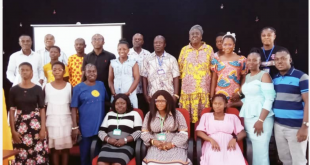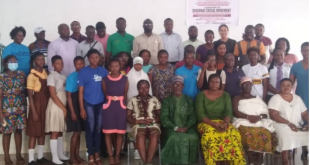clear strategic direction
Reflecting on the 60 per cent reduction in institutional neonatal mortality rate from 5.8 per 1000 live births in 2012 to 2.3 per 1000 live births in 2013, Buckle queried whether the President is by implication saying we are now
concentrating on neonatal health
“There was insufficient articulation of the root causes of our current situation and the fundamental changes that are required in terms of changes in attitudes etc. to rearrange and produce better health outcomes at a population level.”
Dr. Cynthia Bannerman, the Deputy Director of the Ghana Health Service’s Institutional Care Division is, however, quick to assert that “Neonatal care is still a priority”. Pressed to identify the top three interventions that might have accounted for this decline in the institutional neonatal mortality rates, Dr Ebenezer Appiah-Denkyira, the Director General of the Ghana Health Service listed the increasing number of pediatricians being trained, the equipment being supplied, and clinical skills training being given to the health workers to provide better quality care in pre maturity, birth asphyxia and sepsis – leading causes of newborn deaths.
Policy interventions
Dr Buckle argues the point that the President, instead of answering the fundamental question of where we are in health at a national level and outlining corrective policy interventions, chose to highlight a few high functioning areas in disregard of the full national profile. As a typical example, he pointed out how instead of reproducing known technocratic commentary on say capitation as a provider payment mechanism, he would have preferred that the President tackled the critical issue of financing health care as a thematic focus.
Explaining further, he pointed out how unstable markets were affecting for example medical suppliers and the impact that had on health care delivery. With many suppliers being blown out of business both because of national economic challenges and the long reimbursement turn-around time, Dr Buckle called on the President to appreciate the bigger picture and address the question of how Ghana intends to finance health holistically and not position the issue as though certain specific interventions and their effects simultaneously accounted for the total national burden.
Against government’s plans to scale up the capitation policy to the Volta, Upper East and Upper West regions, Dr Bannerman commented on complaints from some health providers about inadequate reimbursements for services rendered under capitation. She described these as “perceptions which can only be verified through objective analysis of the costing structure. We (Ghana Health Service) are meeting with the NHIA to look at the costing objectively which would clarify whether providers are being underpaid or not.”
CHPS? compounds
And still other areas raised by the President in his health address come in for analysis. Government has a laudable plan to build 1600 Community Planning Health Services (CHPS) compounds to address access concerns. The compounds are staffed with trained nurses, midwives, and other auxiliary health personnel and are located in rural and peri-urban communities, to provide basic healthcare services.
With an estimated 940 CHPS compounds currently and a gap of 2500 compounds, the government’s plan to construct 1,600 new compounds will address 64 per cent of the identified gap.
Government, however, appears to be behind schedule already, as to meet the target, a minimum of 400 CHPS compounds per year should be built. This is corroborated by Director General Dr Ebenezer Appiah-Denkyira, who is fairly certain that Ghana did not build 400 CHPS compounds in 2013.
This, he attributes mainly to serious funding constraints in the past year which adversely affected capital investments in the sector. He hopes for a better fiscal picture in 2014.
The director general also described the government’s initiative to support the CHPS construction with a “10 perc cent pay cut” as “a good idea and an example of the commitment to achieving the MDGs.” He called for revenues accruing from those pay cuts to be placed into a special account and the modalities for accessing it for the construction of CHPS compounds to be spelt out, as the GHS complements the effort by identifying potential sites where these compounds will be located.
The President touted the training of “more than 3,000 medical personnel – including medical assistants, midwives, public and community health nurses.” This estimation, Dr Appiah-Denkyira believes, is on the modest side, putting the figure somewhere in the region of 6,500. The director general quickly drew attention to the more pressing issue of difficulties in placing some of these newly trained health professionals of all categories onto the government payroll as a result of severe funding constraints.
He traced this to the fact of government being the number one employer and called for support of a specific kind from government that would strengthen the private health sector to become a more significant employer, thus taking pressure off government payroll while addressing service delivery gaps.
Both Dr Appiah-Denkyira and Dr Bannerman lauded government’s massive infrastructural development under its National Medical Equipment Replacement Programme which has seen modern equipment being supplied to 40 district hospitals. In Dr Bannerman’s words, “retooling is long overdue as most facilities lack basic equipment.”
To address the poor maintenance culture, the director general announced the formation of properly resourced biomedical engineering units in all the regions to regularly maintain this new equipment being installed. Further, all hospitals have been tasked to budget for preventive maintenance ever year.
 DCI-GHANA Defence for Children Internation
DCI-GHANA Defence for Children Internation






